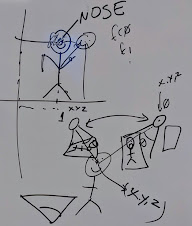(Yeomans et al., 2021)
Contents
Standing posture
human gait and posture
biomechanics
evolution
neural control
animal comparisons?
(Yeomans et al., 2021)#
Bibliography (APA Format)#
Yeomans, M., Yan, S., Hondzinski, J. M., & Dalecki, M. (2021). Eye-hand decoupling decreases visually guided reaching independently of posture but reduces sway while standing: Evidence for supra-postural control. Neuroscience Letters, 752, 135833. https://doi.org/10.1016/j.neulet.2021.135833
Citation Nature Format#
Yeomans, M., Yan, S., Hondzinski, J. M. & Dalecki, M. Eye-hand decoupling decreases visually guided reaching independently of posture but reduces sway while standing: Evidence for supra-postural control. Neuroscience Letters 752, 135833 (2021).
Brief Summary#
1. What did they do (what activities)?
2. What did they measure (what data)?
3. What did they find (what results)?
4. What does it mean (what new knowledge)?
(discussion part of paper)
Researchers had 21 year old males perform tasks involving moving a cursor with their hands either in the direction they were looking or in the opposite direction they were directed to look. These were done once sitting and once standing. The researchers measured sway movements when the subjects were standing to review whole body control.
The researchers measured the reaction time, the direction of movement, the accuracy of the course of movement in relation to the sway, and the velocity at which the participants could keep up (mean hand kinematics). They also collected “frame-by-frame reviews of point-of-gaze and hand movement video data” that was recorded using an eye tracker to determine the accuracy of participant’s movements. Sway data was also collected by averaging medio-lateral displacement and anterior-posterior displacement for the postural part of data.
Overall, they found that when healthy people perform cognitively demanding visuomotor tasks, their postural control is altered. Across each test (reaction time, movement time, path length, and absolute error), the mean hand kinematics values were very similar for sitting and standing. However, the same tests performed under coupled and decoupled conditions showed higher mean hand kinematics for each test.
When performing cognitively demanding tasks involving postural control and hand-eye coordination, participants tended to focus more on the hand-eye coordination aspect of the decoupled task than the postural sway, suggesting that there is limited focus in these tasks and that more may be delegated to hand-eye coordination.
Method figure#

Main Results figure#

